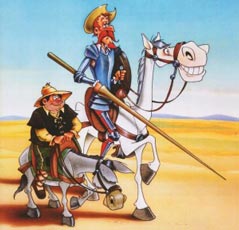As you know, the characters are a fundamental part of any story. They are a must. But what type and how many characters do we need? One could say that we only need a protagonist (the character to whom the events of the story happen) and an antagonistic force or character to oppose the protagonist’s desires or goals. These two elements would be enough to tell a story.

This simplicity is well reflected in short stories which only include the main characters (the fewer, the better). But in the case of longer works such as the novel, adding secondary characters to the equation will give greater depth to the story and help you drive the plot to its conclusion. The construction of secondary characters, as with any other aspect of writing, opens up a world of possibilities, but there are a number of common supporting roles that are useful in any story:
The Sidekick
This character represents the faithful friend who always stands by the protagonist. Some famous examples are Sancho Panza in Don Quixote, Sam in The Lord of the Rings, or Ron Weasley in the Harry Potter series.
The Tempter
This character is the right hand of the antagonist. It’s a secondary character that can help you create new subplots and obstacles the protagonist will face throughout the story. Returning to the example of the Harry Potter series, the tempter would be represented by the character of Peter Pettigrew (nicknamed Wormtail) who works under the orders of Voldemort.
The Skeptic
Although the role of the secondary character who complicates the achievement of the protagonist’s goals is usually taken by the tempter, it doesn’t always have to be like that. Sometimes there are characters who help the antagonist by standing in the protagonist’s way without having anything to do with him. In the Harry Potter books, the secondary role is represented by Uncle Vernon and Aunt Petunia as well as Harry’s cousin Dudley. Although unrelated to the antagonist Voldemort, they also try to sabotage the hero’s progress.
The Driver
This role is one of my favorites, and I like to call it the “Obi-Wan Role” because Obi-Wan Kenobi is one of my most loved characters from the Star Wars saga. The role of the driver is to make the protagonist act in order to set the plot in motion. When the protagonist has doubts about whether to take a path or not (as in the case of Luke Skywalker at the beginning of Episode IV) or gets stuck because he doesn’t know what decision to make, it’s the perfect time for the driver to take part in the story. It’s not necessary for the secondary character to solve all of the protagonist’s doubts. It’s much more interesting if the hero only receives clues that lead him to decide which path to take. It’s just a little push because the final decision should rest with the main character (if it didn’t, he wouldn’t gain knowledge from experience).
In many cases, the role of the driver is carried out by the archetype of the wise old man (or woman) – a character with experience, age, and knowledge who provides the protagonist with the key to solving a problem. However, it doesn’t have to be so. Sometimes an innocent comment by a foolish secondary character can hide the information necessary for finding the solution to a dilemma or for making a decision.
The Mentor
This secondary character requires special mention. Apart from giving the protagonist a key to solving a particular conflict (which is also the role of the driver), he also has the function of guiding the protagonist (for a longer period of time than the driver) and sharing knowledge at crucial moments in order to return him to the right path. Such is the case of Abbé Faria in The Count of Monte Cristo.
The Mixture
Not everything is black or white, and the secondary characters we’ve mentioned don’t have to be exclusively limited to their role. Sometimes we can mix different types of characters to create new roles and add depth to the story. The role of the pseudo-villain is a clear example of how mixtures work – the tempter (or helper of the antagonist) redeems himself towards the end of the story and becomes a driver or sidekick who helps the protagonist achieve his goal.
Of course, this is only a partial list of some of the most common roles secondary characters adopt, but there are many more. Depending on the story you want to tell, you’ll have to decide which of them to use!
Related Posts
How to Give Depth to Your Characters
How to Write Character Sketches
How to Name your Characters
 This site uses cookies. By continuing to browse the site, you are agreeing to
This site uses cookies. By continuing to browse the site, you are agreeing to 



There are no comments in this entry. Go ahead and leave yours!